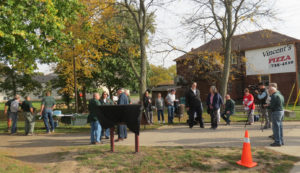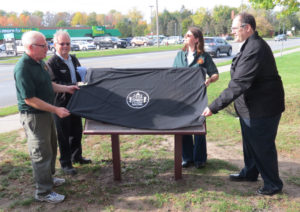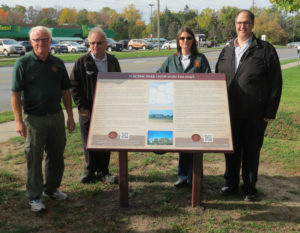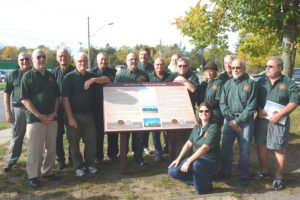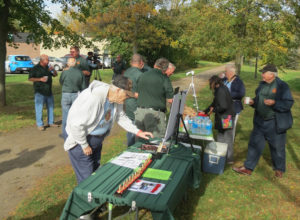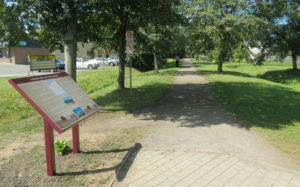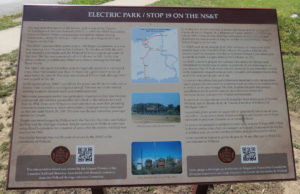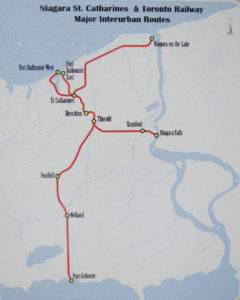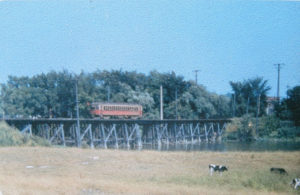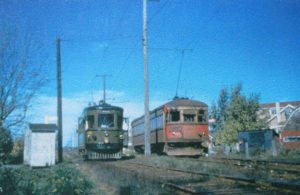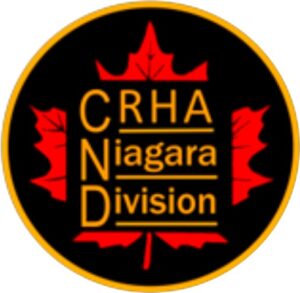Click on the video above to watch the unveiling!
On Monday, October 15th, 2017 we unveiled our fifth historic plaque at Stop 19 (Electric Park) near the intersection of Thorold Road and Rice Road in Welland, Ontario. This article from the Welland Tribune ( http://www.wellandtribune.ca/2017/10/24/celebrating-niagaras-railway-history ) captures the event well. Pictures from the event follow the article.
“The Canadian Railroad Historical Association, Niagara Division, unveiled the Niagara, St. Catharines and Toronto (NS&T) Railway Plaque in Welland Monday morning. Association members presented the plaque to the community at the Recreation Trail’s crossing at Thorold Road where NS&T Stop 19 used to be when the railway was still running. The plaque includes information about NS&T history, as well as historical photos.
The group has installed a couple plaques in other Niagara communities, but in English only. For Paul Chapman, association member, the plaque is an exciting addition because the inscription is written in both English and French. Chapman said Welland is a bilingual city with a diverse heritage, so it was important to reflect that with the plaque. “The French translation was a challenge for certain technical words,” he said. The association had a number of French speakers review the French translation before finalizing the board.
Through fundraising and donations from the Welland Heritage Advisory Committee the association was able to fund the plaque, which cost about $3,000. Tammy Frakking, association president, said it’s important to share Niagara’s history especially rail history because it assisted in the development of the region.
The NS&T connected people from Port Dalhousie all the way to Port Colborne. Not only was it imperative for the economy and business development, but also for connecting families. The electric interurban railway began service in 1899 and ended in 1959. Chapman said in the early days most people didn’t have vehicles, so having the railway offered an opportunity for people to easily travel within the region.
Frakking said the NS&T is interesting because of the current move to bring the GO Train to Niagara. She said having a rail system isn’t a new concept, which is another reason to preserve its history.
Peter Boyce, manager of Welland parks, said the NS&T was ahead of it’s time. And from a personal point, Boyce said he thought it was “amazing” how something so old is actually so new. For Frakking, it’s important to have commemorative plaques because it will hopefully spark community interest in rail history. By having the various plaques within the Niagara Region, she hopes will encourage people to join the CRHA Niagara Division.
“People may see these plaques and start asking questions.”
by Michaelle Allenberg
MAllenberg@postmedia.com
Twitter: @M_Allenberg”
Pictures from the event:
Click on each image for a closer look!
The event drew a substantial crowd on a lovely warm summer’s day!
Left to right: Paul Chapman (CRHA Niagara) , Peter Boyce (Manager – Welland Parks), Tammy Frakking (CRHA Niagara) and Giorgio Giovinazzio (Chair, Welland Heritage Committee)
Left to right: Paul Chapman (CRHA Niagara) , Peter Boyce (Manager – Welland Parks), Tammy Frakking (CRHA Niagara) and Giorgio Giovinazzio (Chair, Welland Heritage Committee)
15 members of CRHA Niagara Division came out to enjoy the unveiling!
Everyone enjoyed refreshments and home-baked goodies afterwards!
The following images and text are displayed on our CRHA Niagara NS&T plaque in Welland near the corner of Thorold Road and Rice Road just west of the intersection on the north side of Thorold Road at the entrance to the Steve Bauer Trail..
We unveiled a new historical plaque at the Recreation Trail’s crossing of Thorold Road, near the intersection with Prince Charles Drive, Welland. The unveiling will occur on Monday, October 23, 2017 at 10:30 AM. The dedication was performed by Welland Mayor, Frank Campion, the City’s Heritage Advisory Committee, and Tammy Frakking, President of the CRHA Niagara Division.
The plaque commemorates the Niagara, St. Catharines and Toronto (NS&T) passenger railway station stop at Electric Park/Stop 19 in Welland, and NS&T’s electric interurban passenger and freight service in Niagara. The NS&T system connected Toronto by boat, and by rail the Main Line between Port Dalhousie, Port Weller, St. Catharines, Merritton, Port Dalhousie, Thorold and Niagara Falls, and the Welland Division that went all the way from Thorold to Welland and Port Colborne. One of Canada’s first electric interurban railways, the NS&T began service in 1899, ending in 1959.
Tammy Frakking, President of the CRHA Niagara Division said, “If local history is not preserved, it is forgotten. The Station stop and tracks are gone; this plaque preserves information for the younger residents of Welland, and visitors to the Niagara region. It is a reminder of a by-gone era; of how our parents and grandparents used to get around Niagara.”
This local history plaque project is the fifth of several planned by CRHA, with funding provided by the City of Welland and the City’s Heritage Advisory Committee.
The Plaque
The trail near this sign is on the former right of way of the Niagara, St. Catharines and Toronto Railroad (NS&T). In 1899, the NS&T was created. It was an electric freight and passenger interurban railway serving communities along the Welland Canal corridor plus Niagara Falls and Niagara On The Lake.
The NS&T expanded their system, and in 1906 began construction of a new line running from Thorold to Port Colborne. By October of 1908, the rails had crossed a new trestle over the Welland River to a station just south of the river. The line was completed to Port Colborne in 1911. In the first photo below (undated) a northbound NS&T car is shown crossing the Welland River Trestle.
The NS&T line, like most interurban systems originally operated as numbered stops. Near this location was Stop 19. Based on a government order, all stops had to be named. This stop was renamed Electric Park although there was no park at the site.
In the second photo below, NS&T cars 620 (in the green) and 83 (in the red) meet at Electric Park. Car 620 is running as a special. This was one of the normal meeting locations between north and southbound cars.
Interurban passenger service was particularly important at that time because most people did not have automobiles and relied on the railways to travel. Even in 1938, there were 18 trains in each direction on most days providing convenient connections to other communities. Passenger service continued on this line until March 29th, 1959. This lien was the last interurban passenger service in Canada.
Freight was interchanged in Welland with the Toronto. Hamilton and Buffalo Railway and the Michigan central. Freight operations to Welland continued using diesel locomotives for a number of year after the electric overhead was removed in 1960.
This display honours the 50 years of service by the NS&T to the community of Welland.
This interpretive board was erected by the Niagara Division of the Canadian Historical Association with the financial assistance of the Welland Heritage Advisory Committee.
NS&T – Major Interurban Routes
Crossing the Welland River Trestle
Image from the collection of Andy Panko
NS&T #620 (green) and #83 (red) Meet at Electric Park
Image from the collection of Andy Panko
